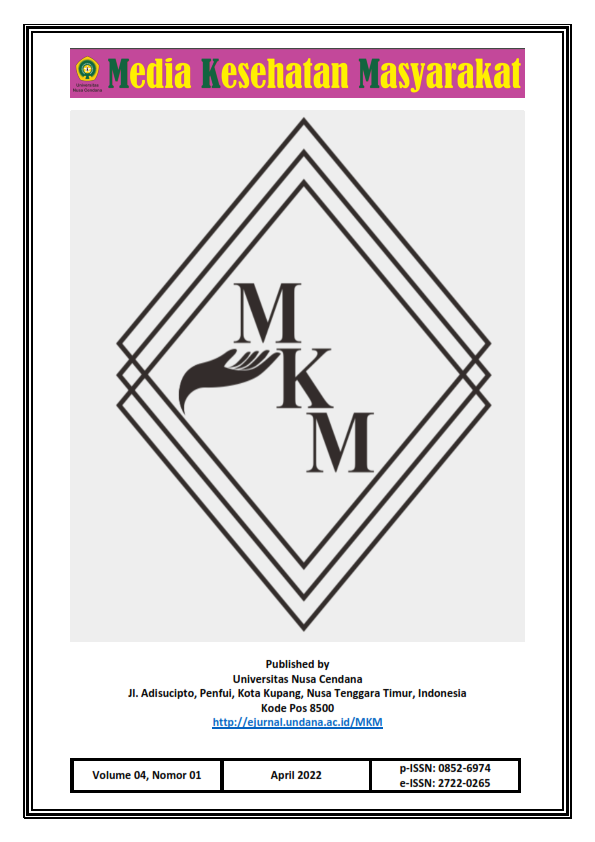Efektivitas Pengolahan Limbah Grey Water Melalui Ecotech Garden Skala Rumah Tangga di Kota Kupang
Abstract
In Kupang City, greywater is disposed of in the environment without any treatment, so it often causes problems in terms of aesthetics, health and exceeds the specified parameter limits. This study aims to determine the effectiveness of the Ecotech garden as one of the methods to treat greywater waste using water ornamental plants. This research type is quasi-experimental with a Group Pretest Posttest Design. The research sample is greywater from the inlet and outlet to be tested in the laboratory. Data were analyzed using the One Way Anova test with a p-value of 0.05, and the quality of wastewater before and after processing would be calculated using the effectiveness formula. Based on the analysis, it was found that the p-value of the three plants was 0,368 and shows that there is no significant difference between the three plants so that one of them can be selected. Based on the effectiveness value, Ecotech garden is considered very effective to reduce the greywater parameters concentration, namely BOD, COD, and TSS by 99% and 97%, while the concentration of ammonia (NH3) and pH both before and after processing are still below the quality standards. The most effective plants are the cattail plants and water hyacinth. It is suggested that Ecotech Garden can be maximally made on a communal scale, such as for housing and boarding houses/ dormitories by using several types of plants to be more effective in treating grey water waste.
Downloads
References
Badan Pusat Statistik Kota Kupang. Kota Kupang dalam Angka 2020 [Internet]. Kota Kupang: Badan Pusat Statistik Kota Kupang; 2020. Available from: https://kupangkota.bps.go.id/publication/2020/04/27/2b60e73717878272a9433335/kota-kupang-dalam-angka-2020.html
Ruslisan, Zahira FS, Dharmasanti R. Prediksi Perubahan Penggunaan Lahan Terbangun Terhadap Kesesuaian Rancangan Tata Ruang Wilayah Menggunakan Regresi Logistic Binner Berdasar Data Spasial dan Penginderaan Jauh di Kota Semarang. In: Conference on Urban Studies and Development (CoUSD) [Internet]. Semarang: E-Journal Undip; 2015. p. 51–67. Available from: http://eprints.undip.ac.id/49783/
Karels DW. Model Spasial dan Faktor Pengontrol Akuifer Airtanah Dangkal Untuk Penentuan Zona Konservasi Airtanah di Kelurahan Oebufu Kota Kupang. J Tek Pengair [Internet]. 2014;5(2):166–71. Available from: https://jurnalpengairan.ub.ac.id/index.php/jtp/article/view/216
Rintayati P. Melestarikan Lingkungan Dengan Ecotech Garden. Surakarta: UNS Press; 2017.
Qomariyah S, Koosdaryani, Fitriani RDK. Perencanan Bangunan Pengolahan Grey Water Rumah Tangga dengan Lahan Basah Buatan dan Proses Pengolahannya. e-Journal Matriks Tek Sipil [Internet]. 2016;4(3):939–45. Available from: https://jurnal.uns.ac.id/matriks/article/view/37103
Jannah MN. Evaluasi Kinerja dan Review Perencanaan Instalasi Pengolahan Air Limbah (IPAL) Non Toksik Rumah Sakit X [Internet]. Institut Teknologi Sepuluh Nopember Repository. Institut Teknologi Sepuluh Nopember; 2015. Available from: https://repository.its.ac.id/71912/
Abdulgani H, Izzati M, S S. Kemampuan Tumbuhan Typha Angustifolia dalam Sistem Subsurface Flow Constructed Wetland untuk Pengolahan Limbah Cair Industri Kerupuk (Studi Kasus Limbah Cair Sentra Industri Kerupuk Desa Kenanga Kecamatan Sindang Kabupaten Indramayu Jawa Barat). BiomaBerkala Ilm Biol [Internet]. 2014;16(2):90–101. Available from: https://ejournal.undip.ac.id/index.php/bioma/article/view/9393
Qomariyah SY. Lahan Basah Buatan Sebagai Pengolah Limbah Cair Dan Penyedia Air Non-Konsumsi. J Ris Rekayasa Sipil [Internet]. 2017;1(1):25–32. Available from: https://jurnal.uns.ac.id/jrrs/article/view/14712
Erwin EP, Joko T, Lanang D. H. Efektifitas Constructed Wetlands Tipe Subsurface Flow System dengan Menggunakan Tanaman Cyperus rotundus untuk Menurunkan Kadar Fosfat dan COD pada Limbah Cair Laundry. J Kesehat Masy [Internet]. 2017;5(1):444–9. Available from: https://ejournal3.undip.ac.id/index.php/jkm/article/view/15794#
Margowati D, Abdullah S. Efisiensi Fitoremediasi Tanaman Bambu Air (Equisetum hyemale) dalam Menurunkan Kadar BOD dan COD Air Limbah Rumah Tangga di Desa Kracak Kecamatan Jibarang Kabupaten Banyumas Tahun 2016. Keslingmas [Internet]. 2016;35(4):316–21. Available from: http://ejournal.poltekkes-smg.ac.id/ojs/index.php/keslingmas/article/view/1679
Tarru RO. Penerapan Metode Ecotech Garden pada Pengolahan Limbah Rumah Tangga Toraja Home Land-Toraja Utara. Dyn Saint [Internet]. 2016;2(1). Available from: http://journals.ukitoraja.ac.id/index.php/dynamicsaint/article/view/311
Firdayati M, Indiyani A, Prihandrijanti M, Otterpohl R. Greywater in Indonesia: Characteristic and Treatment Systems. J Tek Lingkung [Internet]. 2015;21(2):98–114. Available from: http://journals.itb.ac.id/index.php/jtl/article/view/8985
Copyright (c) 2022 Author

This work is licensed under a Creative Commons Attribution-ShareAlike 4.0 International License.

 Elsa Maria Auxiliadora Lekipera da Costa(1*)
Elsa Maria Auxiliadora Lekipera da Costa(1*)














